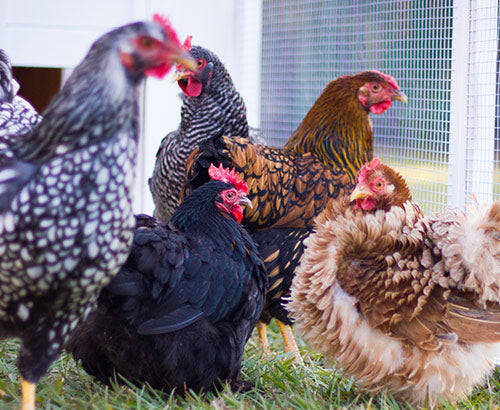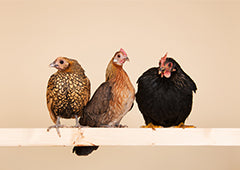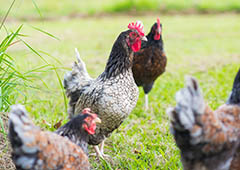One of the most important decisions you will need to make about your chickens is the type of chickens you will keep. You might be surprised to learn that there are hundreds of different types of chicken breeds. In fact, there are more than 400 different breeds of chicken. Considering all of the many options, it can be difficult to make a decision regarding which type of chicken is best for your needs, especially if you are new to the idea of keeping chickens.
The first decision that should be made is whether you prefer to keep standard sized chickens or whether you prefer to keep bantam chickens. Bantams weigh in at only a few kilograms each. Many people who keep bantam chickens do so for ornamental reasons. If your sole reason for keeping chickens is to have them for pets, bantam chooks are an excellent choice. Keep in mind that bantam chickens typically lay less frequently than standard chickens. Furthermore, their eggs are usually smaller in size. Even so, bantam chickens eggs are still edible and delicious. You should also keep in mind that bantam breeds of chicken do tend to be more susceptible to all types of predators, even those that would not ordinarily attack larger chickens.
There are some chicken breeds that can only be found as bantams! These chicken breeds are known as true bantams and includes the beautiful Belgian Bearded D’Uccle, the small and pretty Sebright chicken breed and fluffy and friendly Silkies. Most other chicken breeds are available as both bantam and standard sized chickens.
Of course, if you just can't choose between standard or bantam chicken breeds, you'll be happy to know you can keep both of these types of chickens. Have a peck at our guide to keeping more than one chicken breed in your flock here.

The Wyandotte chicken breed is known for being docile, hardy and friendly. Wyandotte chickens were developed in the United States during the mid-19th century. This chicken breed is thought to have started from mixing Brahmas, Cochins and Hamburgs. Many people love the Wyandotte chicken breed because of its rounded, fluffy appearance. Wyandotte chickens are ideal for both confined keeping as well as free-range. If you plan to raise baby chickens and have an interest in your hen hatching their own eggs, this is a good breed to consider as they are great brooders and make good mother hens. For new chicken breeders, this is an excellent breed to start your flock. You can expect the Wyandotte chicken breed to lay on average of 200 beautiful brown eggs per year. Wyandotte chickens typically grow rather quickly and will reach full size at about 15 weeks of age. They usually begin laying at about 25 weeks.

The Barred Plymouth Rock is an American chicken breed developed during the mid-19th century. There is a difference between the recognised US type of Plymouth Rock chicken and the British type. The UK chicken breed typically has a slightly different shape and stature. One of the great advantages of the Plymouth Rock chicken breed is that it's extremely cold weather tolerant. Due to the docile nature of this chook breed, they're also ideal for keeping in a confined space, although they thrive when kept free-range. Their larger size ensures there are no worries about flying off. These hens are friendly and usually get along well with flock mates.
Plymouth Rock chickens are known for laying a large number of cream coloured eggs. You can expect around 250 large size eggs per year. As with most heritage breed chickens, egg production does drop in the winter, Plymouth Rock hens have been known to lay in the colder months. Like many other large chicken breeds, these hens also have a tendency for becoming broody, so it is important to collect eggs on a regular basis with this clucky breed. This chicken breed is a good choice for young chicken keepers due to their docile and easy to care for nature.

The Pekin bantam chook is one of the cutest chicken breeds! They are well known for their attractively fluffy and round body shape. Pekin Bantams are sometimes confused with Cochins, however the Cochin bantam is derived from a full-sized chicken breed while the Pekin bantam is an actual or "true" bantam and does not have a larger standard size chicken counterpart. Like the Cochin, the Pekin was introduced to the west during the mid-19th century from China. One of the most endearing aspects of this adorable chicken breed is the wide variety of plumage colours and feather patterns available, including silver partridge, lavender, blue, blue mottled, cuckoo, red partridge, Columbian, buff, mottled, wheaten, black and white. These cute chickens don't require as much space as standard size chickens due to their small size. While they can be kept in a confined space, Pekin bantam chickens prefer to peck and forage on grass. These birds are ideal for keeping in a chicken coop as a pet because they are friendly and calm in nature. Pekins are also known for their longevity and overall health. They are excellent layers, although their eggs are small. It is important to collect eggs regularly as the Pekin chicken breed can become broody. If you have small children or only a small area, this type of chicken breed is an eggs-ellent choice.
Old English Game
Old English Game chickens are believed to be the first chicken breed developed in Britain. This chicken breed was originally developed as a fighting bird. While cock fighting has become illegal in most countries, the Old English Game chicken and other game chicken breeds are still popular for exhibition purposes. In the 1930s, the UK Old English Game club split and the Carlisle and Oxford Clubs now recognise two different varieties of Old English Game chickens or OEG. The Oxford version is available in no less than 30 different colours, while there are 13 different varieties of the Carlisle version. It is important to note that OEG males do tend to be aggressive. Therefore, two males should not be kept together. These birds will fight to the death. Even so, when kept as pets, hens can be quite tame. These birds are best suited for free-range. They can be quite active as well as noisy. Chicken keepers should remember that these chicken breeds are active and talented flyers, so a spacious chicken run is a great idea for keeping your Old English Game Game hens safe.

The New Hampshire Red chicken breed is a favourite in the United States, but they're also becoming a popular choice for chicken keepers in the UK and Australia. These chickens are available as a bantam or standard size bird. New Hampshire Reds are a great choice if you are thinking of keeping chickens for eggs. You can expect your New Hampshire Red to lay up to six beautiful brown eggs per week. These birds are also colder weather tolerant and will continue laying well into the colder months. New Hampshire Red chickens are not especially broody and their chicks develop rather quickly. If you're looking for a friendly and hardy chicken breed to keep in your backyard coop, the New Hampshire Red is an egg-cellent choice. They are very easy to tame and can even be picked up by young children. New Hampshire Red chickens do well roaming free or in a spacious chicken run. They do not require high fencing as they are not good flyers. If you intend to show your chickens, these birds are popular for exhibition purposes.

The Jersey Giant chicken breed serves as a dual purpose bird, meaning they proficiently produce eggs and provide meat. Originally developed during the late 19th century in New Jersey, this chicken breed is astonishingly heavy and can reach up to 6kg. Despite their size, Jersey Giants are known for being docile and can be easily tamed. They make excellent pets and will even run to greet their owners and eat from your hand. If you have children, they are quite nice to have around as they do not mind being petted. Due to the size of these chickens, you will need to carefully take your chicken coop size into consideration. These chicken breeds do require more space than other breeds. Nesting boxes and perches will also need to be larger in size to accommodate the hefty Jersey Giant chicken breed. One advantage to this breed is that they do not fly because of their size; therefore, there are no concerns about needing high fences.
These chicken breeds are good for laying and will produce large brown eggs. You can typically expect between three and four eggs per week. Jersey hens can become broody, but they typically do not make the best incubating hens due to their size. They can sometimes break eggs accidentally or even smother very young chicks. These chickens are not very fast growers and usually don't reach full size until about six months of age.

The Hamburg chicken breed originates from Northern Europe and were originally known as Pheasants or Mooneys. Today they are also referred to as Hollands. Known for their elegant appearance, Hamburg chickens are available in a wide variety of colours, including black, white, silver spangled, golden spangled, silver pencilled and golden pencilled. Hamburgs are not particularly large and will only reach around four or five pounds in size. These birds are considered to be good layers and will produce an average of about 4 eggs per week. Although Hamburg eggs are typically small in size, they have a rich taste. Hamburg chickens are not good brooders and they tend to be good flyers, so you will need to have a high fence or secure and spacious chicken run if you plan to keep them contained. Hamburg chickens will begin to lay at about four months of age.

The Frizzle chicken breeds originated about 300 years ago in South East Asia and is usually kept for exhibition purposes. The bantam Frizzle chicken is far more popular than the standard size. Frizzle chickens are available in a wide variety of colours, including black, white, blue, silver-grey and buff. Some lesser common colours include spangle, pile, brown-red, duckwing, Columbian and black-red. These are extremely hardy chickens and will develop quickly. They can be easily left to roam free. If you do choose to keep them in a chicken run, make sure it is secure to prevent your Frizzles from escaping. It is important to keep them indoors if you live in an area where there is a lot of rain as their feathers do not tolerate wet weather well. This chicken breed is great for keeping as a curious, cute and interesting pet. Frizzle chickens lay about 150-200 cream coloured eggs per year.
Dorking

The Dorking chicken breed was originally introduced to Britain from Italy around AD43! This makes them one of the oldest chicken breeds to exist in the UK. A somewhat large bird, you can expect a Dorking to weigh an average of 3-4kg. Dorking chickens can range in colours such as white, red, dark, cuckoo and silver-grey. They're a very docile chicken, making them an excellent choice to keep as a pet. Keep in mind that Dorking chickens can take up to two years to fully mature. This chicken breed can live up to about seven years. As a hardy and adventurous bird, the Dorking loves to forage and requires time and space to free range to be happy and healthy. Dorking chooks are also very social and will get along well with others, including children. Dorking eggs are medium in size and you can expect an average of 3 eggs per week. Hens can be quite broody and it is not uncommon for an entire flock of Dorking hens to cease laying to sit on eggs.
Campine
Campine chickens originally hais from the Antwerp region of Belgium. This pretty chicken breed is available in two different colours; silver campine and golden campine. You can typically expect to receive between two and three eggs per week from a Campine chook. These chickens typically stop laying during the cooler months and rarely go broody, so they don't make good mother hens. A broody hen from another breed or an incubator will typically need to be used for hatching Campine chicken eggs. This chicken breed does best when free ranging as they tend to be flighty, active and inquisitive. Campines are often unique in that while some are friendly others tend to be wild. If you want to keep Campine chickens you may need to clip the wings of your hen as they are good flyers.
Brahma

The big, bold and beautiful Brahma chicken breed originated in India and was later introduced to the UK and US during the mid-19th century. With a majestic appearance, Brahma chooks are popular as ornamental chickens. The most common colours for this chicken breed are triple lace, pencil partridge, Columbian, gold, cuckoo, Buff Columbian and white. Given the sheer size of this chicken breed, you may be surprised at how average their egg size is! They take a bit longer to reach maturity, so expect your Brahma chicken to begin laying at about seven months of age. Once they do begin laying, expect two or three eggs per week. Brahma chickens make excellent brooders and mother hens. If you want to keep chickens as pets, the Brahma breed is a great choice as they are quite docile, can be easily trained and are very social. Brahma chooks are also tolerant of other chicken breeds as well. Due to the size of this chicken breed, you may need more coop space to accommodate your Brahma chickens. This breed does prefer to roam, but can also be happy when kept in a spacious chicken run.
Dominique
The Dominique chicken breed, also referred to as Pilgrim Fowl or Dominicker was once a very common breed of backyard chicken in America. It is believed that Dominique chickens were brought to the US during the colonial period. One of the reasons this breed is so popular is its hardiness. You can expect Dominique hens to begin laying at about six months of age. The eggs are light brown and medium sized. Dominique hens tend to be good brooders and mother hens. You can typically expect these hens to lay two to three eggs per week. Dominique chooks make great pets due to their calm, docile natures, however, roosters can be quite aggressive with other birds and even sometimes the family cat!
The Sussex chicken breed is another popular option if you are looking to keep backyard chickens. Sussex chickens are excellent layers and will produce up to 250 eggs per year. The Sussex chicken breed is also a great for keeping as a pet thanks to them being curious and docile birds. They are excellent at foraging and thrive as as free-range chickens or in a spacious chicken run.

The Leghorn is a classic chicken breed that actually originates from Italy. This chicken breed is quite adept at flying so you may need to clip their wings or keep these flighty ladies in a secure and spacious chicken run in order to prevent backyard chicken coop escapes. Leghorn chickens prefer to roost high up in trees, so it is a good idea to have some high roosting perches inside your chicken run. Like most chooks, the Leghorn chicken breed is clever and prefers to forage freely, but are fine with confinement in a spacious chicken run with plenty of entertainment. The reason Leghorns are so popular is the high egg production you can expect, typically producing about 280 large white eggs per year. It is for this reason that most commercial egg producers prefer this breed. Leghorns begin producing eggs at about 18 weeks of age.
Deciding to become a chicken parent is the easy part. The hardest is deciding on your favourite breed! From lush Leghorns to sassy Silkies, there are so many amazing breeds to consider when starting your own flock. It can be eggstremely overwhelming to find the perfect fit for you and your family. So, where should you begin?
Cluckily, our friends over at Chickenpedia have created an amazing Chicken Breeds Course. This extensive online course shares useful advice on choosing the right chickens for you as well as size & frequency of eggs laid. It really is a great way to find your perfect backyard buddies which is why I highly recommend them to all of my readers! You’ll even learn about their individual personalities, and be able to use their family-friendly compatibility scale through this well-structured program.The courses are beginner-friendly and filled with vital information to help you raise a happy, healthy flock.
As chicken keepers, we want to do an eggcellent job when caring for our feathered friends. Unfortunately, many of us struggle to handle chicken health or behaviour issues, especially in the first few years of having a flock. Chickenpedia have a full range of comprehensive online courses that cover everything you didn’t know you need to know and then some more! From healthcare to raising baby chicks to feeding and behavior, get the knowledge and confidence to successfully look after your chickens.
As a member, you will get access to ALL their fantastic courses. So, no need to wing it, become a confident chicken keeper. Click here to check out Chickenpedia today!
Find out more about which chicken breeds are right for your backyard chicken coop by visiting our top 20 backyard breeds here!

















